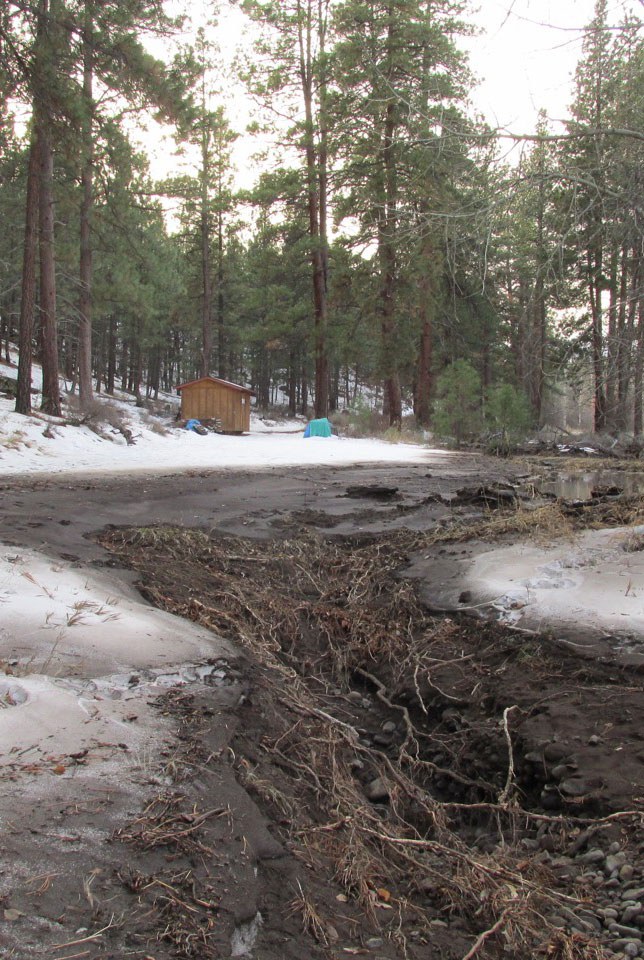At long last, winter seems to have arrived in Central Oregon: the Sno-Parks are bustling, all of Bachelor’s lifts are open, and the high Cascades have finally fulfilled their yearly promise of becoming a snowy wonderland. As the pow piles up, however, the perennial threat of rain-on-snow events looms in every cloudy above-freezing day.
Rain-on-snow events are common--they primarily occur between October and April in the Cascades--but are relatively little understood. Yet, people utter the phrase “rain-on-snow” with a tone of mild dread, at best. What are these somewhat-feared meteorological phenomena, and what do they mean in our part of the Pacific Northwest?

When rain falls on top of snow, there are several possible outcomes, depending on temperatures, existing snowpack, and the amount of rain. It may be useful to think of snow as a sponge, initially: for a while, the snow will absorb rain and hold the precipitation within the snowpack rather than allowing it to run off into the surrounding area. Some studies indicate that liquid water can make up as much as 6 percent of the volume of snowpack. With enough rain, though, snow becomes saturated and forces the rainwater out.
When this happens, a couple of things can happen. Sometimes the rainwater seeps out and increases streamflow in surrounding creeks and rivers, equivalent to the amount of rain that fell in the first place, but in one relatively large pulse. Other times, the warmer temperature of the rainwater melts the snow and creates a much larger runoff pulse that can greatly amplify river flows and can even lead to flooding.
Floods are a rarer, more extreme outcome of rain-on-snow events, and quite difficult to predict. Rain-on-snow floods usually require an intense period of precipitation as rain on top of considerable snowpack, which leads to slow, prolonged snowmelt in snowpack across a large area. This means that a good stretch of rain in the Cascades could significantly increase the flow of the Deschutes River and its tributaries as snow all across the mountain range simultaneously melts and releases its water. These floods can stress dams and riverbanks, damage vegetation, and swiftly decrease the water stored as snow that humans and ecosystems depend on during drier months.
More commonly than floods, rain-on-snow just leaves behind an icy crust and contributes to faster-than-normal snowmelt by warming the ground beneath the snow. This is particularly common in the warmer months of early spring and late fall.
Whether rain-on-snow events lead to damaging floods or just higher than normal rivers, they vastly accelerate a normal part of the water cycle in a way that’s counterproductive and even harmful for humans, plants, soils, and wildlife.
Check out this video for a look at a rain-on-snow event in the Cascades that brought flooding to Camp Polk Meadow Preserve in December 2014:
Unsurprisingly, climate change is going to make rain-on-snow-events worse, at least initially. As Oregon’s temperatures continue to rise, researchers predict that rain-on-snow events will become more common at mid-elevations in the Cascades and other places accustomed to permanent winter snow.
Scientists also predict that the Cascades will receive more rain generally with climate change, and this amplified rainfall will likely lead to more rain-on-snow-induced flooding. At the same time, lower elevations that may have traditionally seen more rain-on-snow events will no longer receive enough snow for these events to occur as frequently.
As mid-winter warm spells in Central Oregon begin, keep an eye out for how rain changes the ways that snow--whether at the mountain or in your backyard--looks, acts, and melts into our creeks and rivers.
Learn more:


